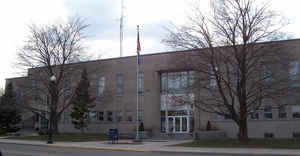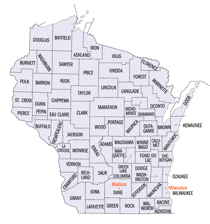Wisconsin Counties
There are seventy-two counties in the state of Wisconsin. Wisconsin became part of the Territory of Michigan and divided into two counties: Brown County in the northeast along Lake Michigan and Crawford County in the southwest along the Mississippi River. The state of Wisconsin was created from Wisconsin Territory on May 29, 1848, with 28 counties.Shawano County, Wisconsin
Shawano County Education, Geography, and History

Shawano County (originally Shawanaw County) is a county located in the state of Wisconsin. Based on the 2010 census, the population was
41,949. Its county seat is Shawano.
Shawano County is included in the Shawano, WI Micropolitan Statistical Area, which is also included in the Green Bay-Shawano, WI Combined
Statistical Area.
Etymology - Origin of Shawano County Name
Named for the lake of that name within its borders. The word is a Chippewa term, somewhat modified, and signifies "southern" - Wis. Hist. Colls., xii. It is similar to the French Chaouanon (English, Shawnee), a tribal term. There is no evidence that the Shawnee Indians ever lived in this locality. It was probably the southern boundary of Chippewa tribal territory, although later claimed by the Menominee.
[Source: Kellogg, Louise Phelps. "Derivation of County Names" in Proceedings of the State Historical Society of Wisconsin for 1909, pages 219-231.]
Demographics:
County QuickFacts: CensusBureau Quick Facts
Shawano County History
Shawano County, created in 1853 from Oconto County, is named from a Menominee word Sawano, meaning South. Located
in northeast Wisconsin, the county seat is Shawano.
Its name is from a modified Ojibwa term meaning "southern"; A Menominee Chief named Sawanoh led a band that lived in
the area. Many citizens of Shawano believe the lake, county, and city (Town of Shawanaw founded 1853 and changed to
Shawano in 1856), were named after Chief Sawanoh, despite a historical marker placed in 1958 near the lake along Highway
22 which claims the lake was named because it was the southern boundary of Chippewa territory. No documented proof has
been provided to date, to establish either case as preemminent and so both may be correct depending on the oral history
of the people you talk to. There are various historical recordings of the spelling of Shawano including: Sawanoh,
Shawanaw, Sharuno, Shabin, Savannah, Savanah... which show the influence of French, German, and English translation (v's,
w's, and b's, sounding very similar and thus being recorded incorrectly at times). The disparity probably comes from a
human tendency to miss subtle differences in the articulation of words/names, especially from languages other than our
native tongues. This disparity in translation is also evident in the Mahican/Mahikan/Maikens tribe vs. Mohegan/Mohecan/Morhican
tribe vs Mohicans (from the fictional story by James Fenimore Cooper: "The Last of the Mohicans").
The Stockbridge-Munsee Community, (Mahican), is located in Shawano County in the towns of Bartelme, and Red Springs.
The History of Shawano County
by Dave Maas
The history of Shawano county prior to 1843 would rightly be the history of the Menominee and Chippewa Indians. They
hunted and fished the rivers and lakes of this region for hundreds, if not a thousand, years prior to the arrival of
the Europeans. A few Europeans wandered near the region two centuries earlier, Jean Nicolet, a Frenchman, who landed
near Green Bay in 1634 while seeking a route to the Orient; and the French explorers Pierre Radisson and Medart des
Grossilliers established a dwelling at Chequamegon Bay in 1659, where missionaries later constructed a mission. In
1673 Father Marquette and Jean Nicolet again journeyed through the region, but did not settle. Few if any Europeans
actually walked on the soil that would become Shawano county until Samuel Farnsworth came to the region in 1843. He
came to this location having paddled up the Wolf River in a canoe from New London. He found this region to be a vast
forest with fine stands of pine, hemlock, cedar, and maple.
Samuel Farnsworth realized the potential that lumbering held for this land. He returned to Oshkosh and legally
acquired the land to erect a sawmill at the junction of Wolf River and the Shawano Lake outlet. A year after his
first visit to the Shawano area (1844), he dispatched a crew lead by Charles D. Wescott to transport machinery and
provisions north to the Wolf River site. The equipment was barged up the Wolf River by Indian crews who labored
using long poles to propel the barges. On the 10th of November, 1845, the first steam-powered boat, The Manchester,
arrived at what is now Shawano on the Wolf River.
By the year 1851 logging had spread out from the Shawano area to other rivers that flowed into the Wolf. Besides the
Charles Wescott lumbering enterprise, other companies saw the forests as rich supplies of lumber and logging camps
sprung up north of Shawano. In the year 1853 the population of the region had grown to 254 inhabitants and "Shawanaw"
County was established as a separate county from sections of Oconto and Outagamie Counties. The name Shawanaw comes
from the Indian Sha-wa-Nah-Pay-Sa which meant "lake to the south" in Menominee and Chippewa. The change in spelling
of Shawanaw to the present spelling of Shawano occurred in 1864. Shawano became the county seat. Once established,
the Shawano area grew steadily. In 1855, the population had grown to 300 and by 1860 the region held 829
inhabitants. During the first ten years the settlers that came to Shawano County were primarily people from the New
England states and Canada. As the community grew and the land became logged off, Germans came in large numbers to
clear the land of stumps, drain the swamps and establish their farms that remain to this day as splendid picturesque
landscapes.
The large influx of Germans started to arrive in Shawano County in the late 1860s. A majority were Pomeranians from
the Northern reaches of then-Prussia (Germany). Their homeland was Pommern, a strip of land on the south shore of
the Baltic, land and climate not at all different from central and northern Wisconsin. They adapted perfectly to a
region that resembled their homeland and carved wonderful farms from a forbidding landscape populated with millions
of stumps and even more glacial rock and boulders. Joining these European pioneers were also Bohemians, Norwegians,
Irish and, to a lesser degree, English and French.
In 1870, Shawano County had grown to 3,165 people. The village of Shawano became incorporated in 1871. Shawano
became a city by Chapter 278, Laws of Wisconsin, which was passed March 19, 1874, comprising the same lands included
under the village charter. The county continued to receive an influx of immigrants throughout the 1870s, and 80s. By
1900, the best farmland had been settled and the numbers of immigrants decreased. While lumbering still played a
small part in the economy after 1900, the primary economy was dairy farming and the industries associated with it.
The last federal census (1990) shows that the county now boasts a population of 37,157.
Geography: Land and Water
As reported by the Census Bureau, the county has a total area of 909 square miles (2,355 km2), of which, 893 square miles (2,312 km2) of it is land and 17 square miles (44 km2) of it (1.85%) is water.
Neighboring Counties
Bordering counties are as follows:
- Menominee County - north
- Oconto County - east
- Brown County - southeast
- Outagamie County - south
- Waupaca County - south
- Portage County - southwest
- Marathon County - west
- Langlade County - northwest
Education







